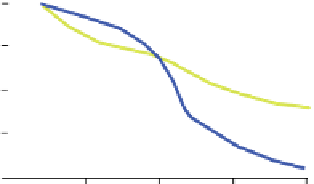Geoscience Reference
In-Depth Information
Poisson Ratio, AI and Shale/Sand
AVO Responses
Shallow
Deep
Class IV
Class III
Class II
0.5
IV
0.4
Shale
0.3
Class I
III
Sand
II
0.2
I
gas effect
40 000
30 000
10 000
Acoustic Impedance (ft/s, g/cm
3
)
20 000
Fig. 5.9
Schematic plot of Poisson's ratio against acoustic impedance.
(positive or negative) but the AVO effect leads to high negative amplitudes at far offsets.
Some authors distinguish a class IIp, where the zero incidence response is positive
and therefore there is a polarity reversal at an intermediate offset. Class III responses
have large negative impedance contrasts and the negative gradient leads to increasing
amplitude with increasing angle. Class IV response occurs where a large negative
amplitude decreases slightly with offset. Confusingly, a reflector is sometimes referred
to as exhibiting
positive AVO
if the amplitude, irrespective of sign, increases with
offset.
In a clastic sequence, the AVO classes are related to differences in consolidation of
sands and shales with depth
(fig. 5.9)
. The general increase in impedance with depth
(fig. 5.10
)
reflects the decrease in porosity due to compaction. Class I responses are
characteristic of deep well-consolidated sections, and class III responses of relatively
unconsolidated shallow sediments. Class IV can occur in very unconsolidated sands,
shallower than about 1000 m, or where soft sands are found below a non-clastic hard
layer. The feature that distinguishes it from class III is the very low gradient; in practice
it is often hard to say in real seismic gathers whether a low gradient is positive or
negative because of scaling issues to be considered shortly.
A common method of AVO analysis is the AVO crossplot.
R
0
and
G
can be calculated
for each loop on every CMP gather in a seismic survey, by measuring the amplitude and
calculating the best fit to a plot of
R
(
θ
) against sin
2
θ
. The resulting pairs of
R
0
,
G
values
can be charted on the crossplot and, as we shall see shortly, may give us information on
fluid fill and lithology. Of course, we do not directly observe the incidence angle
θ
,but




























